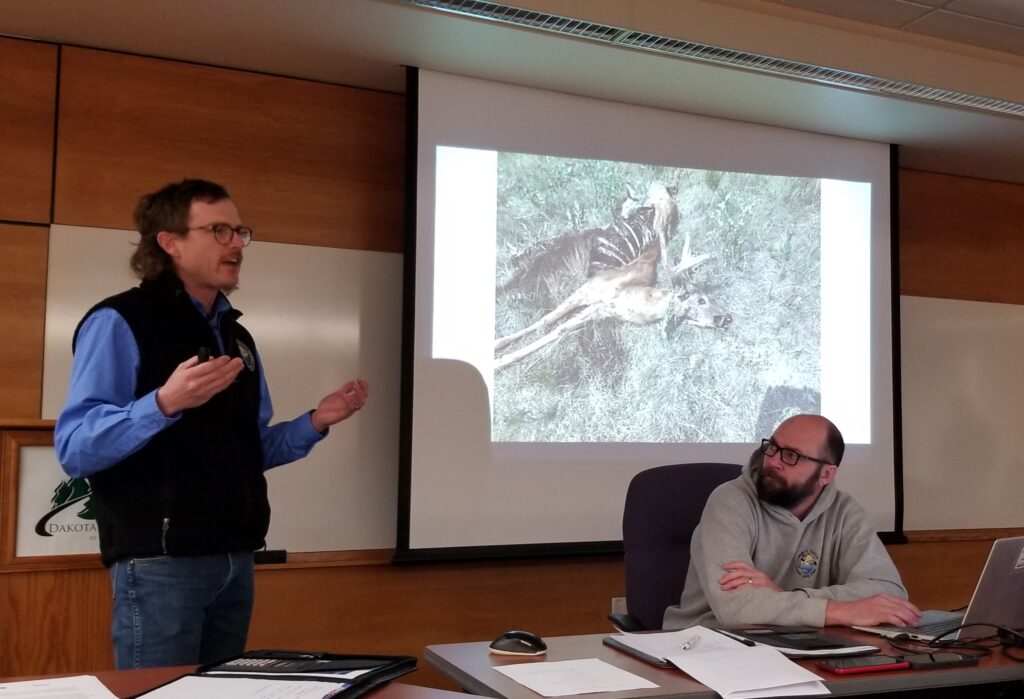

BOTTINEAU – The precise effect of an outbreak of epizootic hemorrhagic disease in the state this year remains unclear, but there is little doubt that it was substantial. The disease, known commonly as EHD, resulted in the deaths of many white-tailed deer over much of North Dakota, primarily the western half.
“There was pretty dramatic mortality in the state,” said Charlie Bahnson, North Dakota Game and Fish Department veterinarian, while addressing sportsmen at a NDGF Advisory Board meeting here Tuesday night.
“There was pretty dramatic mortality in the state.” Charlie Bahnson, NDGF veterinarian
EHD is spread by a biting midge, sometimes called “no see-ums". This past year dry conditions resulted in receding shorelines that created mud flats ideal for breeding midges. Adding to what resulted in a sort of perfect storm, freezing temperatures that kills midges and brings a halt to the spread of the disease, was up to four weeks later than usual over much of the affected area.
While Game and Fish had received numerous reports from landowners, bowhunters, and others regarding the finding of dead deer, it wasn’t until the state’s pheasant hunters got into the field October 9th that the extent of the problem became vividly apparent. Pheasant hunters are drawn to areas, cattail sloughs, and creek bottoms, where an abundance of dead deer were found.
EHD produces a fever that causes affected animals to seek water to cool down. Many reports of deer carcasses came from the Missouri River corridor all the way through the state. Similarly, reports of additional deer deaths came from other drainages and wetlands. So many deer deaths were reported that Game and Fish offered refunds to deer gun license holders who decided not to hunt. About 3,500 hunters received refunds.
How many deer died remains unknown, but NDGF hopes to learn more about the extent of the die-off during aerial deer surveys this winter. However, biologists caution that about one-foot of snow is necessary to conduct a reliable count. Nevertheless, it is already apparent there will be an effect on the 2022 deer season.
“We don’t know what percentage of deer died,” Casey Anderson, Wildlife Division chief, told the gathering. “Obviously, tag numbers in those units will look a little bit different next year.”
Bahnson explained that the disease was fast acting, killing deer in as little as 48 hours. White-tailed deer are particularly vulnerable, much more so than other cervids in the state such as mule deer, elk, and moose. Fortunately, he said, not all deer die from EHD and the herd actually builds up a temporary immunity. He added that back-to-back outbreaks of EHD in the same area is not likely.
“We are optimistic, at least hopeful, that the deer will come back.” Brahnson
“EHD is cyclical,” said Bahnson. “We are optimistic, at least hopeful, that the deer will come back.”
Another topic of concern for the state’s deer herd is chronic wasting disease. Unlike EHD, said Bahnson, CWD “grows and grows and always gets worse.”
CWD was first detected along the North Dakota-South Dakota border in 2009. Since then it has been found in the northwestern and west-central parts of the state, and northwest of Minot. Other cases are known just across the Red River on the state’s border with Minnesota, and near Baker, Montana, just outside North Dakota’s southwest border with that state.
The fatal prion disease is spread by deer through close contact and remains on the landscape. Because of that, Game and Fish has implemented baiting bans in some hunting units and has placed restrictions on the transfer of deer heads and spinal columns, which is known to carry the disease, outside of affected units.
Jeb Williams, NDGF director, told the attendees that a statewide ban on baiting is not imminent, but remains a possibility in the future.
“I’m not sure at what point in time it does make sense as a true preventative measure to eliminate baiting altogether.” Jeb Williams, NDGF director
“When does it make sense to eliminate baiting in North Dakota?” asked Williams. “I’m not sure at what point in time it does make sense as a true preventative measure to eliminate baiting altogether.”
Williams also asked sportsmen and landowners for input on a new electronic posting procedure implemented by Game and Fish this year. Few comments were received regarding the new system.
Jason Lee, North-Central District fisheries supervisor, highlighted proposed changes to the 2022-24 ND fishing proclamation. Those changes included allowing spear fishing year round for non-game fish, increasing the statewide smallmouth and largemouth bass limit from three to five, and to allow for the darkhouse spearing of walleye on the Missouri River system and Devils Lake.
Declining water levels due to drought conditions, said Lee, will be problematic for boat ramps next spring. Lee explained that a dozen boat ramp projects that got underway late this year have not been completed due to a variety of issues ranging from access to easements.
"If we lose another 2 ½ feet on Devils Lake the ramps there will be marginal or not useable.” Jason Lee, North-Central District fisheries supervisor
“There’s 58 boat ramps on Lake Sakakawea and Lake Oahe,” said Lee. “If the drought continues it will mean low reservoir levels. A lot of our low water ramps have been under water for a long time and need repair work, parking lots, and more. If we lose another 2 ½ feet on Devils Lake the ramps there will be marginal or not useable.”
Game and Fish presented a video on the department’s Meadowlark Initiative, a program to promote landscape habitat through collaboration of several agencies to promote healthy, thriving grasslands.
The Tuesday evening meeting was the second in a series of eight Advisory Board meetings to be held throughout the state. The final meeting is scheduled for December 7 in Amidon.